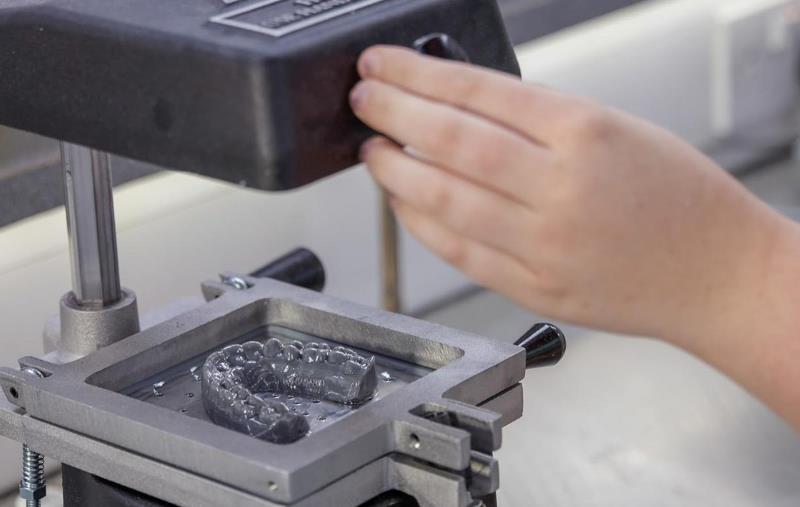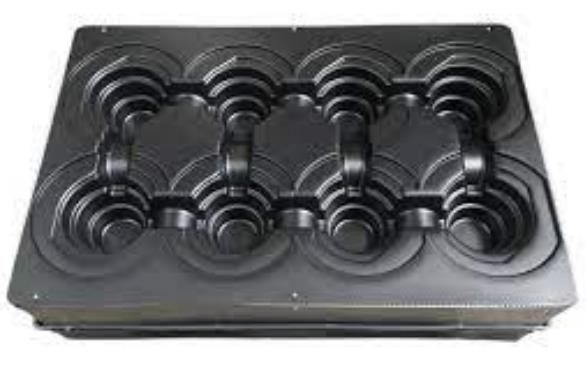An example of a vacuum form is the plastic packaging for toys and action figures, like those seen in retail packaging.
Basics of Vacuum Forming
Definition and Overview
Vacuum forming, a type of thermoforming, involves heating a plastic sheet until it becomes pliable, then applying vacuum to mold it over a specific form. This process is widely used due to its simplicity and cost-effectiveness in producing plastic parts. Key advantages include low tooling costs, rapid prototyping, and the ability to create detailed parts with minimal waste. Typically, vacuum forming machines range in power from 2kW to 10kW, depending on the size and complexity of the parts being formed.

Historical Development
The historical roots of vacuum forming trace back to the 1930s, initially used for simple applications like chocolate molds. Over the decades, advancements in materials and technology have significantly expanded its applications. By the 1950s, vacuum forming began to take a prominent role in industrial manufacturing. The introduction of high-impact polystyrene in the 1970s was a major leap, allowing for stronger and more durable products.
Material Advancements and Quality
Advancements in materials, such as the development of acrylics and high-density polyethylene (HDPE), have broadened the range of products that can be vacuum formed. These materials not only offer improved durability but also enhance the quality of the final product. For example, HDPE can withstand temperatures of -30 to 120°C, making it suitable for both outdoor and high-temperature applications.
Efficiency and Speed
In terms of efficiency, modern vacuum forming machines can produce parts within a cycle time of 2 to 5 minutes, depending on the size and thickness of the material. This speed is beneficial for mass production. The cost of vacuum forming is generally lower compared to other forming techniques, especially for medium to large-sized productions.
Size and Specifications
The size and specifications of vacuum formed parts can vary widely. Standard machines can handle sheets ranging from 0.5mm to 6mm in thickness and up to 2 meters by 3 meters in size. Custom machines can handle even larger sizes for specific industrial applications.
Lifespan and Value
The lifespan of vacuum-formed products depends on the material used and the application. For instance, products made with ABS plastic can last for several years under normal use. The overall value of vacuum forming lies in its ability to produce lightweight, strong, and cost-effective parts quickly and efficiently.
Further Reading: Vacuum Forming – Wikipedia
Types of Vacuum Forms
Thermoforming Plastics
| Aspect | Description |
|---|---|
| Materials Used | Commonly includes ABS, polystyrene, and polycarbonate. |
| Power Requirement | Ranges from 3kW to 15kW based on machine size and material thickness. |
| Cost-Efficiency | Relatively low tooling and setup costs. |
| Lifespan | Varies with material; ABS parts can last 5-10 years. |
| Speed | Cycle times can be as low as 3 minutes per part. |
| Size & Specifications | Can process sheets from 1mm to 8mm thickness, up to 3m x 4m size. |
| Advantages | Flexibility in design, suitable for custom and complex shapes. |
| Limitations | Not ideal for very high-volume productions due to longer cycle times compared to other methods. |
Further Reading: Thermoforming – Wikipedia
Deep Draw Forming
| Aspect | Description |
|---|---|
| Materials Used | Typically utilizes thicker plastics like high-density polyethylene (HDPE). |
| Power Requirement | Generally requires more power, around 10kW to 20kW. |
| Cost Implications | Higher tooling cost due to deeper and more complex molds. |
| Durability | Produces parts that are robust and have a longer lifespan. |
| Production Speed | Slower process due to deep drawing requirements; average cycle time is around 5-8 minutes. |
| Product Dimensions | Specialized for creating deep, large, or intricate parts. |
| Advantages | Excellent for creating durable and sturdy components with significant depth. |
| Challenges | More expensive for short runs due to higher tooling costs and slower cycle times. |
Further Reading: Deep Drawing – Wikipedia
Vacuum Forming Process
Step-by-Step Guide
Material Selection: Choose appropriate plastic, considering thickness (typically 0.5mm to 6mm) and type (like ABS or polycarbonate).
Heating: Heat the plastic sheet. Standard machines use 2kW to 10kW power.
Molding: Place the heated sheet over the mold.
Vacuum Application: Create a vacuum to form the plastic around the mold.
Cooling: Cool the formed plastic to retain its shape.
Release: Remove the finished product from the mold.
Trimming: Trim excess material for a finished look.
Machinery and Equipment
Vacuum Forming Machine: Core equipment, varies in size. Small machines start at 2kW power; larger ones reach 20kW.
Heating Element: Infrared heaters are common, crucial for even heat distribution.
Vacuum Pump: Essential for creating the vacuum. Efficiency varies with model.
Molds: Made from materials like wood, aluminum, or resin. Cost varies with complexity.
Trimming Tools: Used for post-forming processes.
Key Advantages: Vacuum forming is cost-effective and flexible for various designs. It’s ideal for prototypes and small to medium-sized batches.
Limitations: Not suited for high-volume productions due to longer cycle times and higher tooling costs for complex shapes.
Further Reading: Vacuum Forming Process – Wikipedia
Materials Used in Vacuum Forming
Commonly Used Plastics

ABS (Acrylonitrile Butadiene Styrene): Popular for its strength and flexibility. Ideal for automotive parts and consumer goods. Offers a lifespan of 5-10 years depending on usage.
Polystyrene: Lightweight and cost-effective. Used in packaging and disposable containers.
Polycarbonate: Known for its impact resistance and clarity. Perfect for protective gear and medical devices. Can be more expensive than other plastics.
PVC (Polyvinyl Chloride): Offers good chemical resistance. Common in plumbing and medical tubing. It’s also flame retardant.
PETG (Polyethylene Terephthalate Glycol): Combines clarity with chemical resistance. Used in food packaging and medical containers.
Material Selection Criteria
Cost Efficiency: ABS and polystyrene are budget-friendly. Polycarbonate and PETG cost more but offer specific benefits.
Durability and Lifespan: Consider the expected lifespan. ABS and polycarbonate are durable, while polystyrene is less so.
Application Specifics: For example, PETG is preferred for food contact and medical applications due to its safety and clarity.
Environmental Factors: PVC and polycarbonate offer good resistance to chemicals and weather.
Design Requirements: Some plastics, like polycarbonate, allow for more intricate designs due to their flexibility.
Further Reading: Thermoplastic – Wikipedia




